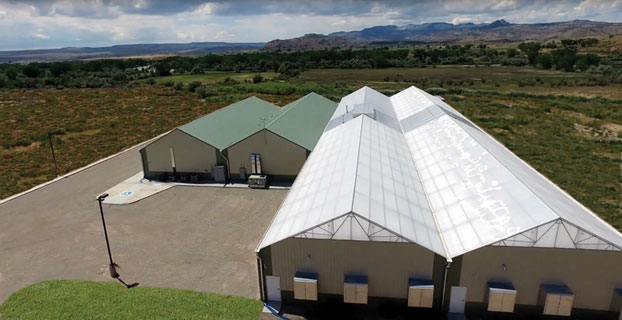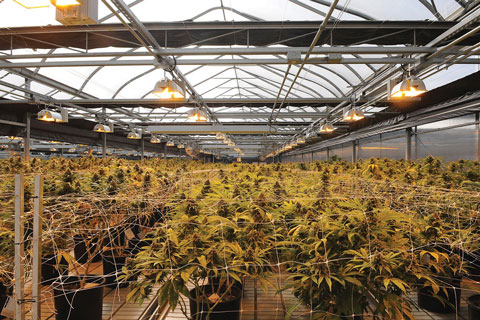3/1/2018
Potted vs. “Pot”
Jennifer Zurko
Despite the recent announcement from the current attorney general, it’s business as usual for those involved in the cannabis industry.
In early January, Jeff Sessions revealed plans to rescind an Obama-era directive that instructed federal prosecutors not to prioritize prosecuting businesses like dispensaries in states that had legalized cannabis.
However, many news outlets like Newsweek, The Washington Post and Forbes reported that 2018 will be a pivotal year for states looking to legalize cannabis, either medicinally or recreationally. At least 12 more states have passed legislation or are in the process of introducing bills for decriminalization or legalization of marijuana. If all of them pass, that means that four states (Idaho, South Dakota, Nebraska and Kansas) will be the only ones that don’t have a least some type of cannabis-use laws on the books.
Since cannabis has become more decriminalized and some of the prior stigmas about the possession and use of it have waned, there are more businesses opening grow houses and dispensaries. Many of them are investment and venture capital companies looking to finance in a new market. But some are current or former ornamentals growing operations that are turning their greenhouses into places to grow cannabis.
Converting an existing ornamentals greenhouse into one for cannabis isn’t that simple, however. Yes, cannabis is a plant—which actually has similar growing conditions to cut mums—but some of its needs exceed those typically used for traditional ornamental plants.
What’s similar
The structure
Paul Golden is an engineer for Nexus, getting his start in the greenhouse industry with ornamentals in the early 2000s. Within the last decade, Nexus has been able to expand to serve other markets, including controlled environment agriculture, urban rooftop greenhouses and, of course, cannabis. He’s in charge of design and implementation of new products and has seen how popular the cannabis market has become.
“It’s a pretty big market for us,” Paul explained. “We’ve been heavy throughout the entire legal market—we’re in our sixteenth state right now, with about 1.5 million sq. ft. of built facilities.”
And Paul thinks that number will increase significantly now that recreational cannabis is legal in California, which could outrank other states combined just because of its size.
As more bans are lifted by states, there are more opportunities to get in on the action. And if you already have a greenhouse, you’re ahead of the game.
Light
True, there are many businesses developing indoor grow houses for cannabis—and there are some benefits to growing cannabis in a warehouse. But growing in a greenhouse allows you to take advantage of a special element from Mother Nature that you can get for free: light.
Warehouse cannabis has a large environmental footprint, particularly with how much power it needs for lighting and HVAC. Cannabis is a high-light crop; it needs a minimum of 30 mols a day, so artificially creating that indoors can be costly. Most professionals in the hort biz recommend growing cannabis in a greenhouse so you don’t have to spend as much money on lots of lights that also bring a secondary issue of dealing with the heat they put out.
“Everybody’s got a warehouse and they want to replicate it in a greenhouse and that’s not what it should be,” said Duane Van Alstine, Project Manager for GGS Structures. “You should utilize what the greenhouse has to offer, which is your free light and your air.”
“One of the things that’s in common with an ornamentals greenhouse is that light transmission is important, but it’s even more important for cannabis,” said Dr. Brian Corr, who has more than four decades of experience in the greenhouse industry. For the last three years, Brian has advised legal cannabis producers. “The amount of light they need is similar to greenhouse tomato production. Your tomato yield is positively correlated to your light levels and cannabis is the same way—more light, more yield.”
Blackout cloth system

Cannabis may need a lot of light for maximum yield, but only produces flowers if the daylength is less than a critical photoperiod. Most growers use a 12-hour day/12-hour night photoperiod for flowering, so require a blackout system for much of the year. If you grow poinsettias or mums, you have one of these, although most cannabis growers use a three-layer cloth to get an extra degree of blackout, said Duane.
Pictured: Some municipalities don’t want cannabis growing in a greenhouse to be seen from overhead if you happen to be flying over in an airplane. Nexus uses a 100% diffused covering where you can maybe see the blackout screens inside the greenhouse, but not what’s underneath it. Photo courtesy of Nexus
Brian said, “Light leaks can delay or prevent flowering or provide stress that results in production of ‘hermaphrodite’ plants—female plants that produce stray male flowers, which can result in pollen production yielding seeds instead of quality flowers.”
GGS builds “the same structure for the flower guy down the street as we would for the cannabis guy,” said Duane. But after the structure and blackout curtain, that’s where the similarities end.
What’s different
Cost
Cannabis greenhouses tend to have a lot more controls and a lot more systems in place. In an ornamentals greenhouse, you can open the roof to level out the temperature and have a simple control system, which is relatively inexpensive. But cannabis greenhouses need more sophisticated systems.
“They really dial [cannabis greenhouses] in so they’re more of factory or a plant where you guarantee consistency year-round,” said Paul. “They tend to have a high number of lights, benches, heating and cooling systems—so it’s easy for a cannabis facility to be 50% more than an ornamental facility in cost up-front.”
G

reenhouse height
Having an existing greenhouse is good, but it has to be one with a specific gutter height.
Pictured: Most cannabis houses should have a 12- or 14-ft. gutter height due to the height of the crop and to get enough light through the canopy. Photo courtesy of GGS Structures
“Most cannabis houses have either a 12- or 14-ft. gutter height and the reason is because typically you place lighting on the bottom of the truss, and due to the height of this crop, if they’re growing it on a bench, the plant is at the right working height for most people to trellis and support its heavy buds,” explained Paul. “We’re talking about 5.5 to 6 ft. off the ground, including the bench. And in order to get a good spread between those lights, you want to have that light separated at the top of the canopy by about 6 ft. in most cases.”
Greenhouse walls and (sometimes) roof
If you grow cannabis inside, it’s easy to hide. But if you’re growing in a greenhouse, many local municipalities require the side walls to be non-transparent, so that you can’t tell what’s inside from the street.
Duane said that some even require more than that. He’s built a cannabis greenhouse in a municipality in Nevada that doesn’t want you to be able to see what you’re growing if you happen to be flying over the greenhouse in an airplane, so GGS offers a polycarbonate that’s a light layer with a black layer in the middle, so you get the reflective qualities from the sunlight, but you can’t see through it. Nexus takes a similar approach with its roof covering, often using a 100% diffused covering where you can barely see the blackout screens inside the greenhouse, but not what’s underneath it, said Paul.
Odor mitigation
Anyone that’s ever attended any rock/hip-hop concert knows that marijuana tends to be … ahem … a tad aromatic. Another element many municipalities require cannabis growing operations to have is a special system that masks or eliminates the odor.
GGS is located in Vineland Station, Ontario, Canada, where the Canadian government recently legalized recreational cannabis across all provinces beginning this year. Health Canada (Canada’s equivalent to the Federal Drug Administration), says you can’t have any type of odor coming out of your greenhouse, said Duane. So growers need exhaust systems that treat the air to eliminate the smell.
Paul said that you can also have an exhaust system with a mister that sprays an aerosol that attaches to the odor molecules from the cannabis that completely changes the odor. You can choose scents like cinnamon or fresh cut grass. There are even compounds developed specifically for the odors unique to cannabis. Think of it like Febreze for your cannabis greenhouse.
Dehumidification/concrete floors
Brian said that cannabis doesn’t get any more diseases than any other plant, but it’s very susceptible to two: powdery mildew and Botrytis. It’s bad enough when you get them on your rose or geranium crop, which you can try and fix with a fungicide. But it’s doubly horrible if you get them on your cannabis—especially since it’s being ingested into the human body in some form and there aren’t any pesticides approved by the EPA for cannabis, so there’s little you can do about it.
“You can have a good crop coming along and you’re getting close to harvest and all of a sudden you have powdery mildew and Botrytis,” said Brian. “A lot of states have standards of allowable levels of mold. You can imagine someone who is ill, particularly someone who has a compromised immune system, if they’re inhaling mold spores … that’s not good.”
To avoid this, investing in a dehumidifier is critical. Ornamental growers have the luxury of opening the roof vents to level out the humidity. Once the blackout curtain is put in place, you can have “dead air,” said Duane, “where mold and mildew can run rampant. But they’re not cheap.” Dehumidifiers can run a minimum of $15 to $20 per square foot.
Another way to minimize excessive humidity is to have the floors in the greenhouse completely covered with concrete. Gravel floors will act as a wick for moisture, sending it straight up to your cannabis crop, said Brian. So many growers go the extra mile and put in concrete, which can be pricey as well.
Security
This is the most important difference between growing annuals and growing cannabis. Every place that allows medicinal or recreational cannabis requires that growers invest in some sort of security system, beginning with fencing around the perimeter of the greenhouse, cameras that cover every square foot and sensors that detect movement, but the rules can be different depending on your location.
“That’s something most greenhouse people have never given a thought to,” said Brian. “And no two places have the same exact
requirements.”
So included with your design or retrofit plans, you have to make sure security is a big part and that you’re covered under the law.
Cannabis is a high-value crop and you have to protect it—not just with a secure structure, but also a reliable environmental control system.
“You have basically a $200 plant; in ornamentals, an orchid is worth $20 a piece,” said Duane. “So, and I say this to all the customers: Don’t cut corners. Don’t go with a cheap little control system—get the best and it’ll pay back tenfold. You don’t want the risk of something going wrong and losing any part of your crop.” GT